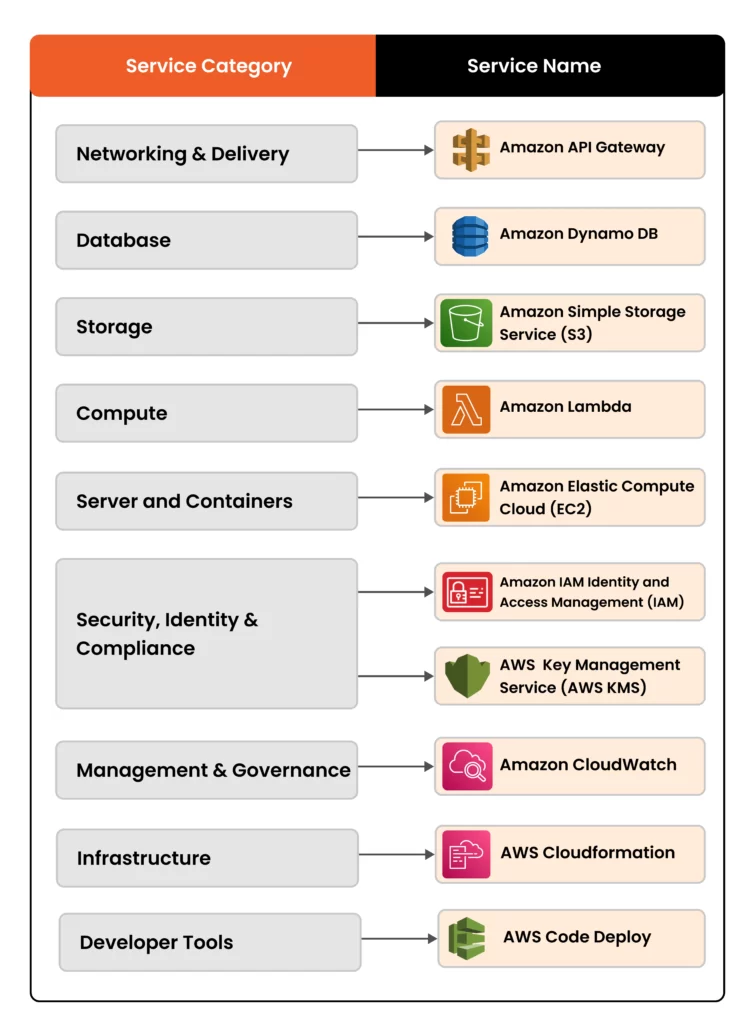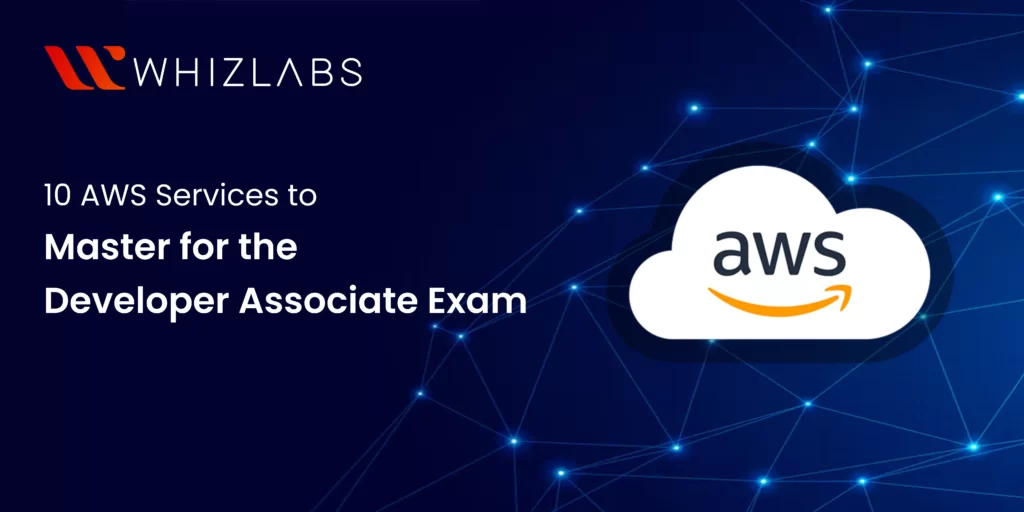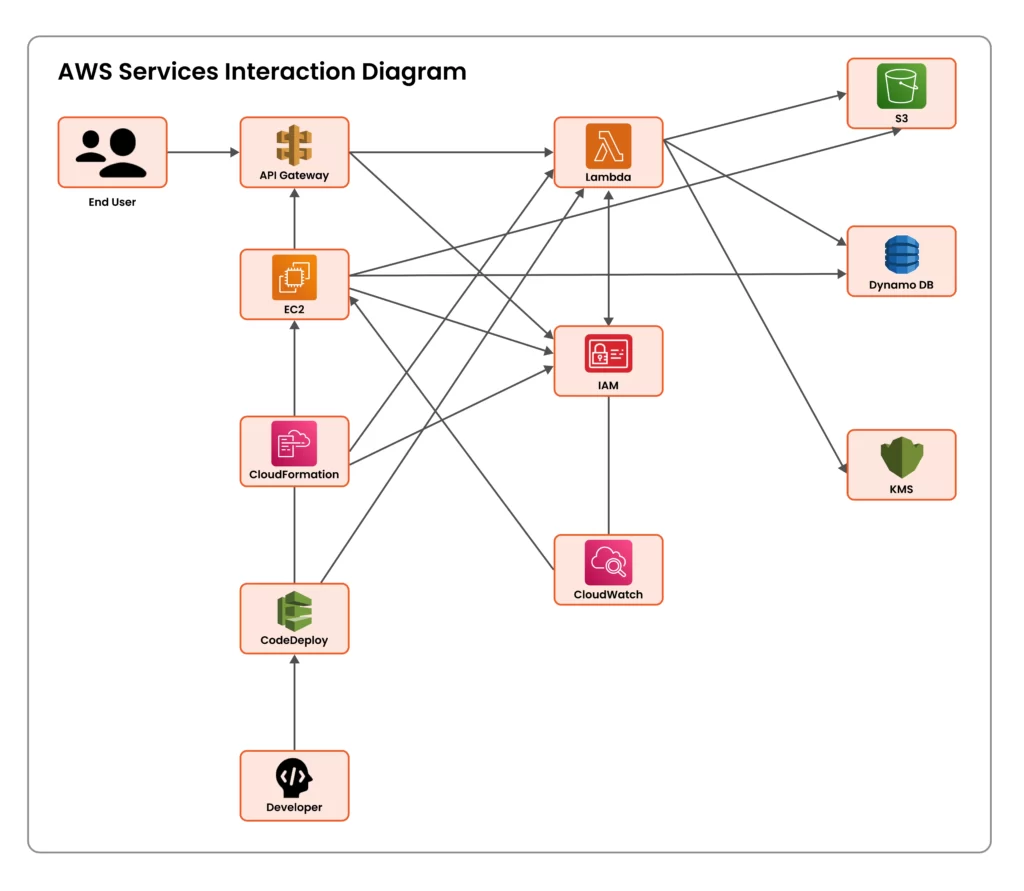For IT and cloud development professionals who want to transition to a cloud career, the AWS Certified Developer Associate exam serves as the ideal springboard. This exam checks your knowledge in developing, testing, deploying, and debugging AWS cloud-based applications. It’s an introductory-level exam without any formal technical prerequisites; however, your ability to recognize the core features of AWS services and how they interact will help you prepare better and pass the exam.
As of 2024, AWS offers over 200 fully featured services. AWS Certification does not officially publish the services and features covered in a certification exam. However, the AWS Certified Developer Associate exam includes questions on 30+ services covering the four exam domains—development, security, deployment, and troubleshooting and optimization. In this blog, we will talk about the top 10 AWS services for the Developer Associate Exam. The following table lists these services and the categories they belong to.
Top 10 AWS services and the categories they belong to

Service 1: Amazon API Gateway
The Amazon API Gateway service lets you publish, maintain, monitor, and secure APIs at any scale. It supports stateful (WebSocket) and stateless (HTTP and REST) APIs and is the entry gate for applications to access data, business logic, or functionality from your backend services. API Gateway offers a complete API management solution by integrating with a wide range of AWS services. It allows you to:
- Create and deploy REST and WebSocket APIs to different stages and manage different API versions.
- Leverage AWS administration and security tools, such as AWS Identity and Access Management (IAM)
- Integrate with Amazon CloudWatch and monitor your operations with a metrics dashboard to monitor calls to your services, latency data, and error rates
Service 2: Amazon EC2
Amazon Elastic Compute Cloud (EC2) offers infrastructure as a service and provides resizable compute capacity as E2 instances. It allows you to:
- Host virtual machine on E2 instances
- Store data on virtual drives called Elastic Block Storage (EBS)
- Distribute load across machines using Elastic Load Balancer (ELB)
- Scale the services using an Auto Scaling Group (ASG).
EC2 integrates with most AWS services including the rest of the nine services mentioned in this blog, making it a versatile choice for a wide range of use cases.
Service 3: AWS Lambda
AWS Lambda is a serverless compute service that provides virtual functions. It allows you to run your application code in AWS without provisioning any servers. Further, it automatically scales on-demand in response to incoming requests and ensures high availability. Here are some of the Lambda features:
- Supports Java, Go, PowerShell, Node.js, C#, Python, and Ruby code, and provides a Runtime API which allows you to use any additional programming languages.
- Runs custom code in response to events from other AWS services or any web or mobile app, making it ideal for serverless application
- Processes requests within milliseconds; allows a function to run up to a maximum of 15 minutes per invocation
Service 4: Amazon S3
Amazon Simple Storage Service (S3) is an object-based storage service that allows you to store and retrieve any amount of data from anywhere by using a web service interface. Here are some of the S3 features:
- Manages data as objects, rather than in file systems or data blocks, within buckets. You can upload any file such as photos, videos, code, documents, and text files, with a max of 5TB for each object.
- Offers elasticity with unlimited storage that grows and shrinks as you add or remove data.
- Offers data protection using Object Lock, S3 Replication, and S3 Versioning.
Service 5: Amazon DynamoDB
DynamoDB is a serverless NoSQL or non-relational database that supports document and key-value data models, providing fast and predictable performance with seamless scalability. It allows you to store and retrieve any amount of data and serve any level of request traffic. Here are some additional DynamoDB features:
- Provides flexibility with schemaless design—no additional data type is required other than the primary key attributes
- Supports three data types (number, string, and binary) and JSON, HTML, and XML as document formats
- Supports two types of consistency reads—eventually consistent and strongly consistent—to deliver a consistent single-digit millisecond latency at any scale
Service 6: AWS IAM
AWS Identity and Access Management (IAM) is a security service that enables you to securely control access to AWS services and resources for your users and applications. You can manage permissions, roles, and policies to ensure that only authorized users can access specific resources. Further, it allows you to:
- Safeguard the root user by creating and managing AWS users using IAM roles
- Securely integrate hybrid, on-premises, and multi-cloud workloads using IAM Roles Anywhere
- Leverage a single pane of glass for storing and managing users’ identity data in one location.
Service 7: AWS KMS
AWS Key Management Service (AWS KMS) is an encryption and key management service that helps you create and manage cryptographic keys. It integrates with many AWS services such as S3, DynamoDB, and Lambda to encrypt data in those services just with a click. You can use KMS to:
- Enable centralized encryption control with a single view
- Encrypt, decrypt, and re-encrypt data with symmetric or asymmetric KMS keys
- Define key policies to to specify permissions and control access to your to encryption keys
Service 8: Amazon CloudWatch
Amazon CloudWatch is a monitoring and management service for monitoring the health and performance of your AWS resources and applications that run on AWS and in your data center. You can create an alarm to monitor any CloudWatch metric. In addition, using CloudWatch, you can:
- Use a single agent (CloudWatch agent) to define your metrics and collect logs from your Amazon EC2 instances and hybrid, multi-cloud, and on-premises data sources.
- Create a centralized logging space using CloudWatch Logs to collect logs from all of your systems, applications, and AWS services.
- Gain insights into performance patterns and troubleshoot your applications using existing system and application log files.
Service 9: AWS CloudFormation
AWS CloudFormation is an infrastructure-as-code service that enables you to manage, configure, and provision your AWS in a declarative way. By using CloudFormation, you can:
- Ensure consistent and repeatable deployments by creating CloudFormation templates, which are declarative files that define and describe the resources you want to provision
- Use YAML or JSON template to outline your infrastructure and automatically provision and configure resources
- Manage different AWS services with a single template by integrating CloudFormation with other AWS services
Service 10: AWS CodeDeploy
AWS CodeDeploy automates application deployment that works with EC2 instances, on-premises system, and Lambda, and ECS services. As deployment are automated, CodeDepl allows you to quickly release new features and avoid downtime during deployments. You can use CodeDeploy to:
- Deploy any application across different platforms as CodeDeploy is programming language and architecture agnostic
- Avoid downtime during application deployment using the blue-green strategy
- Stop a deployment or roll back to previous deployed revision of the application, in case of a failed deployment to maintain application high availability
Services interaction
Understanding how different services interact is vital for answering scenario-based questions in the AWS Certified Developer Associate exam. Many questions require you to analyze a scenario and determine the best approach, which often involves knowing how services can be combined. The following scenario illustrates how these 10 services are combined for inventory management of an e-commerce company.
Scenario
A growing e-commerce business wants to develop a scalable, secure, and cost-efficient web application, with real-time inventory management capabilities. The application will let customers browse items, add them to a cart, and purchase them. The inventory data must be updated on the fly to reflect stock availability.
Flow of Operations
This is how the services will interact during provisioning, configuring, and managing cloud resources.
User-side interactions
- User interaction: A customer accesses the e-commerce website hosted on S3, browsing products and adding items to their cart.
- API requests: When the customer places an order, the API Gateway routes the request to a Lambda function.
- Business logic: The Lambda function processes the order, updates the inventory in DynamoDB, and triggers a payment process.
- Data security: IAM secures all interactions between services Sensitive information, such as payment details, is encrypted using AWS KMS before being stored in DynamoDB.
- Order processing: The EC2 instances handle complex tasks like processing payments and generating order confirmation emails.
Developer-side interactions
- Deployment and updates: Developers deploy any updates to the application using CloudFormation and CodeDeploy, ensuring that both EC2 instances and Lambda functions are updated without downtime.
- Monitoring: CloudWatch logs the performance of the API calls, Lambda executions, and EC2 instances, providing real-time insights into the application’s health.
Conclusion
This exam tests your knowledge of the core AWS services and how you use that knowledge for developing, deploying and debugging cloud-based applications. This blog intends to introduce you to the core services that are fundamental to most AWS architecture and have high exam coverage. By learning how these services integrate, you are not only better equipped to answer scenario-based questions but also to explain how AWS approaches security, networking, data storage, and compute capabilities. For a thorough exploration of other AWS services, sign up for the AWS Certified Developer – Associate course. For additional hands-on experience of the services, check our AWS hands-on labs and AWS sandboxes.
- Top 20 Questions To Prepare For Certified Kubernetes Administrator Exam - August 16, 2024
- 10 AWS Services to Master for the AWS Developer Associate Exam - August 14, 2024
- Exam Tips for AWS Machine Learning Specialty Certification - August 7, 2024
- Best 15+ AWS Developer Associate hands-on labs in 2024 - July 24, 2024
- Containers vs Virtual Machines: Differences You Should Know - June 24, 2024
- Databricks Launched World’s Most Capable Large Language Model (LLM) - April 26, 2024
- What are the storage options available in Microsoft Azure? - March 14, 2024
- User’s Guide to Getting Started with Google Kubernetes Engine - March 1, 2024



